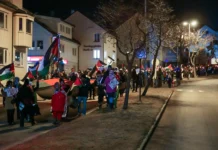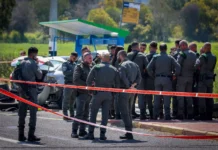Hezbollah fired 19 rockets at northern Israel on Aug. 6, and IDF artillery units returned fire into Southern Lebanon. The situation has been quiet since, but the idea that the escalation is “behind us” is deceptively misleading.
A more sober assessment of the situation leads to the conclusion that the countdown to a direct Israel-Hezbollah clash has begun, and the Aug. 6 incident has brought us one step closer to that confrontation.
Yet the August rocket fire is a different case altogether. It began with rockets launched on Aug. 4 targeting northern Israel, by a so-called “rebellious” armed Palestinian group in Lebanon. Israel responded with airstrikes in Southern Lebanon—for the first time in many years—and Hezbollah then fired its salvo, claiming formal responsibility for the attack.
This development is being fueled by four key components that form the larger picture. The first is the presidential changeover in Iran. The installation of Iranian President Ebrahim Raisi to power forms a new opportunity for the Islamic Republic to signal its intentions in the region.
Secondly, the internal political and economic situation in Lebanon is an inseparable influencing factor. While it is impossible to determine whether Lebanon is collapsing or not, it’s clear that events such as the resignation of the Lebanese prime minister, the ever-worsening economic crisis and the failure of Beirut to recover from the August 2020 port blast are increasing pressure on Hezbollah. And when Hezbollah feels that the flames within Lebanon get too hot, it can be expected to redirect them towards Israel to take the pressure off itself.
The third key influencing factor is Iran’s ongoing entrenchment program in Syria. The Islamic Republic remains determined to use Syria as a launchpad for pursuing its destabilizing interests and objectives, as well as those of Hezbollah. This creates a constant source of friction between the Iranian axis and the Israel Defense Forces.
Finally, the situation in Gaza is projecting onto events in Lebanon as well. After the May conflict between Israel and Hamas, several key issues remain in dispute, such as the entry of Qatari funds and Hamas’s demands for an increased flow of goods into the Strip that it rules. Now, Hamas has a new way of pressuring Israel, without endangering Gaza, by operating from Lebanon with Hezbollah’s consent.
Thus, looking at the rocket fire as an isolated incident leads to an inaccurate conclusion. The full strategic picture involves linking all four factors together. Blaming the escalation on “rebellious groups” serves an Israeli interest of playing down the incident, by clearing Hezbollah of responsibility, meaning that Israel does not need to respond more seriously.
Yet rocket attacks cannot happen without the approval of Hezbollah.
Rejecting Hezbollah’s equations
The recent developments represent a troublesome attempt by Hezbollah to force its “equations” on Israel, according to which, any Israeli airstrikes in Lebanon result in immediate Hezbollah retaliation.
If Israel refrains from launching airstrikes in response to future rocket attacks from Lebanon, it will mean that Hezbollah has been able to deter Israel. The need to reject this equation is extremely significant for Israel, which sent the wrong signal after the Aug. 6 rockets by responding only with artillery shells.
If Israel does not nip this equation in the bud, it will enter a tailspin in which Hezbollah, rather than Israel, dictates the rules of the game in the region.
The fact that Hezbollah now possesses some 150,000 rockets and missiles is a fait accompli. The main challenge now for Israel is to prevent the Hezbollah-Iranian program to create precision-guided missile (PGM) production sites across Lebanon, under buildings, near stadiums and next to medical clinics.
Israel has in recent years publicly exposed a number of such PGM sites in order to raise international attention to this dangerous activity, as well as to let Hezbollah know that it is exposed and vulnerable, and to call on it to stop producing PGMs.
Israel’s campaign between the wars against PGM activity in Syria is not foolproof, and transfers of such technology to Lebanon continue. Hence, the day where Israel will have to take action against the Hezbollah-Iran PGM program in Lebanon is drawing closer.
Israel must now prepare for the possibility that a new clash with Hezbollah is closer than ever and to place itself in the position of being able to take advantage of such a clash to target the PGM threat in Lebanon.
The Israeli government must prepare its public for this eventuality, and the military must prepare itself. However, it’s also important for Israel to choose its own timing for such an event, rather than be dragged into Hezbollah’s preferences.
Such a clash does not automatically mean all-out war, and could take the form of a number of “battle days.” Yet even those will not be similar to the recent escalation with Gaza.
While Hezbollah is unlikely to go for its all-out offensive capabilities and flood Tel Aviv with rockets during “battle days,” it could fire hundreds or thousands of rockets at northern Israel at ranges that go far beyond the Aug. 6 attack (around 20 kilometers, or 12.5 miles).
In such a scenario, Haifa could become the “Ashkelon” of the north and come under heavy fire. Such a scenario is realistic and not far-fetched.
The time has therefore come for Israel to internalize the new reality taking shape. Sweeping the latest incidents under the carpet as “isolated events” is a strategic mistake that promotes a false narrative.
Brig. Gen. Zvika Haimovich (Ret.) is a publishing expert at The MirYam Institute. As the commander of the Israel Air Defense Forces from 2015-18, he was at the helm when the David’s Sling and Arrow 3 systems became operational.

























